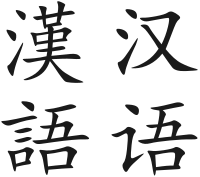 In Chinese writing, there are two kinds of words– the traditional kind and the simplified kind. The traditional kind usually has more strokes involved, while the simplified (as the term implies) is normally much less complicated. Traditional characters are pronounced the same way as their simplified counterparts are.
In Chinese writing, there are two kinds of words– the traditional kind and the simplified kind. The traditional kind usually has more strokes involved, while the simplified (as the term implies) is normally much less complicated. Traditional characters are pronounced the same way as their simplified counterparts are.
For example, here are the characters for “traditional character” (fán tǐ zì) in Chinese.
Traditional:繁體字
Simplified: 繁体字
Clearly, the middle character written in traditional form takes much longer to write than the simplified one. However, as shown above, not all characters are different, as the first and last characters in the phrase stay the same.
Here’s another example with the character for “noodle” (miàn tiáo):
Traditional:麵條
Simplified:面条
Both characters drop what we call their “Bu Shou” (部首) or radical, to make the character easier to write. Traditionally, the Bu Shou is used to distinguish homophones in Chinese, but people can also understand what simplified characters mean in context.
More examples:
“Love” Ài
Traditional:愛
Simplified: 爱
(The 心 (xīn), which means “heart,” has been taken out and replaced with other strokes.)
“Like” (xǐhuān)
Traditional:喜歡
Simplified:喜欢
“Happy” (kāixīn)
Traditional:開心
Simplified:开心
Traditional characters are widely used in Taiwan, Hong Kong, and Macau. Some traditional Chinese characters are even found in Japanese and Korean writing, with the same or similar meanings in all three languages.
Simplified characters are widely used in mainland China and Singapore. Simplified characters are easier to write and remember for most foreign students, so learners of the Chinese language usually learn the simplified characters. Also, simplified characters are more prevalent and used by more people in the world.
People who know only one type of character can often understand the other type because of the similarities in their structure and by using context clues.
Hopefully, this article really enlightened you on the differences and similarities of the traditional and simplified characters of the Chinese written language! See you guys next time!
Click here to learn how to form Chinese characters! 🙂

I thoroughly enjoyed learning the differences between the 2 styles.
Thanks for a great article.
作者不仅对中国文化有深入的了解,还能将中国文字加以分析,真是太不简单了!
作者不僅對中國文化有深入的了解,還能將中國文字加以分析,真是太不簡單了!
簡體字雖然比較簡單 但是反體字看起來比較有美感
简体字虽然比较简单 但是反体字看起来比较有美感